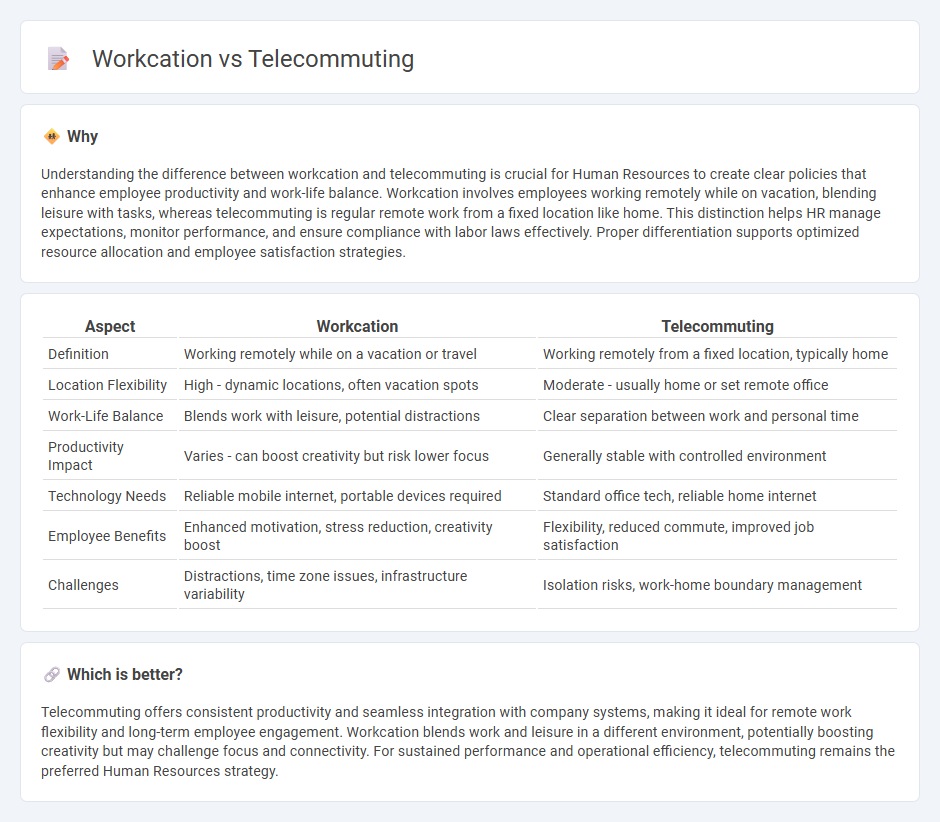
Workcation combines remote work with vacation by allowing employees to work from travel destinations, boosting creativity and work-life balance. Telecommuting involves performing job duties entirely from home or a fixed remote location, enhancing flexibility and reducing commute stress. Explore how these work models impact productivity and employee satisfaction.
Why it is important
Understanding the difference between workcation and telecommuting is crucial for Human Resources to create clear policies that enhance employee productivity and work-life balance. Workcation involves employees working remotely while on vacation, blending leisure with tasks, whereas telecommuting is regular remote work from a fixed location like home. This distinction helps HR manage expectations, monitor performance, and ensure compliance with labor laws effectively. Proper differentiation supports optimized resource allocation and employee satisfaction strategies.
Comparison Table
| Aspect | Workcation | Telecommuting |
|---|---|---|
| Definition | Working remotely while on a vacation or travel | Working remotely from a fixed location, typically home |
| Location Flexibility | High - dynamic locations, often vacation spots | Moderate - usually home or set remote office |
| Work-Life Balance | Blends work with leisure, potential distractions | Clear separation between work and personal time |
| Productivity Impact | Varies - can boost creativity but risk lower focus | Generally stable with controlled environment |
| Technology Needs | Reliable mobile internet, portable devices required | Standard office tech, reliable home internet |
| Employee Benefits | Enhanced motivation, stress reduction, creativity boost | Flexibility, reduced commute, improved job satisfaction |
| Challenges | Distractions, time zone issues, infrastructure variability | Isolation risks, work-home boundary management |
Which is better?
Telecommuting offers consistent productivity and seamless integration with company systems, making it ideal for remote work flexibility and long-term employee engagement. Workcation blends work and leisure in a different environment, potentially boosting creativity but may challenge focus and connectivity. For sustained performance and operational efficiency, telecommuting remains the preferred Human Resources strategy.
Connection
Workcation and telecommuting both leverage remote work technologies to enhance employee flexibility and productivity by allowing work outside the traditional office setting. Workcation combines leisure travel with professional responsibilities, enabling employees to maintain job performance while experiencing new environments. Telecommuting supports this model by providing the infrastructure and policies needed to perform tasks remotely, fostering better work-life balance and employee satisfaction.
Key Terms
Remote Work Policy
Remote work policy shapes telecommuting by outlining employee eligibility, communication expectations, and performance metrics to ensure productivity and accountability outside the traditional office. Workcation policies blend work and leisure, emphasizing flexible schedules, connectivity support, and guidelines for balancing work tasks with vacation time. Explore detailed policy frameworks to optimize remote work arrangements for business success.
Productivity Metrics
Telecommuting enhances productivity metrics by offering flexible work hours and eliminating commute time, leading to higher employee focus and output. Workcation combines leisure with work, often boosting creativity and reducing burnout, but its impact on consistent productivity metrics varies depending on the work environment and individual discipline. Explore detailed studies and data analyses to understand which model best suits your productivity goals.
Work-Life Balance
Telecommuting offers employees the flexibility to work remotely, enhancing work-life balance by eliminating daily commutes and allowing personalized schedules. Workcations blend work with leisure in vacation settings, promoting relaxation while maintaining productivity, which can reduce burnout and improve mental health. Explore the differences and benefits of telecommuting and workcations to optimize your work-life balance strategies.
 dowidth.com
dowidth.com